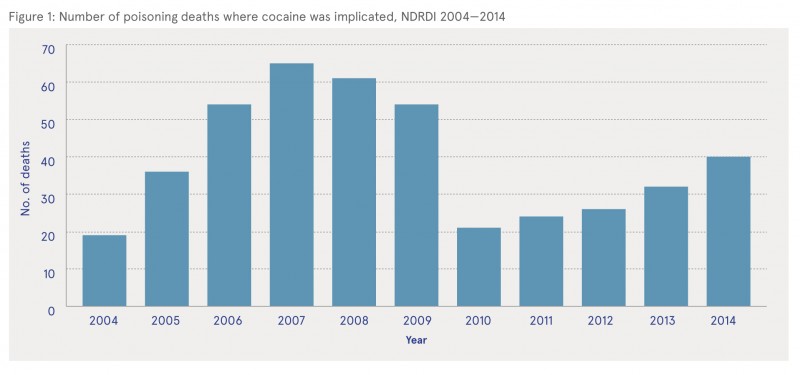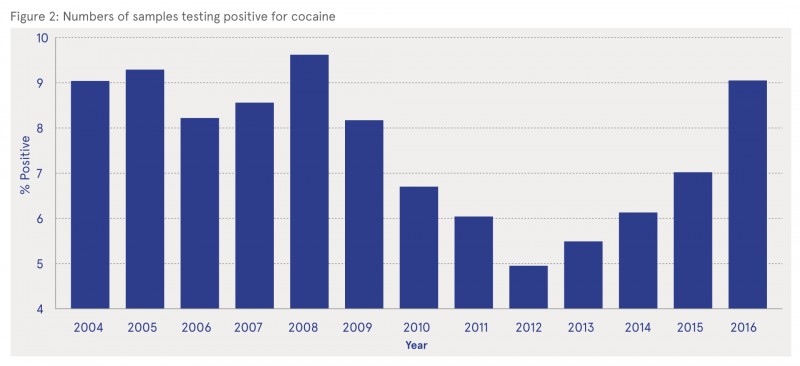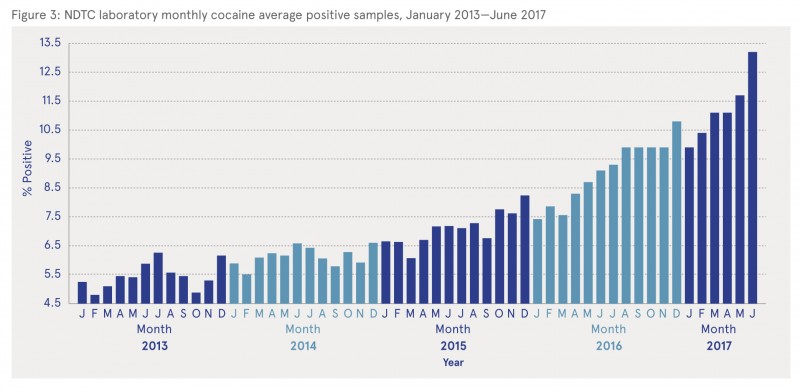Stokes, Siobhan (2017) Increase in cocaine use among OST patients. Drugnet Ireland, Issue 63, Autumn 2017, pp. 28-30.
| Preview | Title | Contact |
|---|---|---|
|
PDF (Drugnet Ireland 63)
1MB |
According to the European Monitoring Centre for Drugs and Drug Addiction (EMCDDA) annual report for 2017 on estimates of drug use in the European Union (EU),1 cocaine is the most commonly used illicit stimulant drug in Europe. It is estimated that 17.5 million European adults (aged 15—64 years), or 5.2% of this age group, have experimented with cocaine at some time in their lives. Among these are about 2.3 million young adults aged 15 to 34 years (1.9% of this age group) who have used the drug in the last year. Only Ireland, Spain, the Netherlands and the United Kingdom (UK) report last-year prevalence of cocaine use among young adults of 2.5% or more.1 The 2014/15 general population survey reported that 2.9% of young Irish adults had used cocaine in the last year.2 Around one million seizures of illicit drugs are reported annually in Europe. Cocaine is the second most commonly seized drug (after cannabis). In total, around 87,000 seizures of cocaine were reported in the EU in 2015. Both the number of cocaine seizures and the quantity seized increased between 2014 and 2015 in Europe.1
Cocaine use in Ireland
In Ireland, in 2015, drug seizures conducted by An Garda Síochána alone included 108,817 grams of cocaine at an estimated street value of €7,617,223.3 Increased seizures of cocaine have been reported by Forensic Science Ireland.4 Information on the strength of cocaine currently in circulation in Ireland is not known. However, in 2015, Forensic Science Ireland reported that the average purity of 158 bulk cocaine samples analysed was 40% (range 0.03—91%), while that of 36 street cocaine samples analysed was 24% (range 0.1—78%); 21 from Dublin (average 28%) and 15 from outside Dublin (average 19%).4
The National Drug Treatment Reporting System (NDTRS) recorded cases of treated problem drug and alcohol use in Ireland between 2009 and 2015. Cocaine remains the third most common drug reported. In 2015, 10.4% of cases reported problem cocaine use, the highest proportion since 2010.5
European drug data
European Drug Emergencies Network (Euro-DEN Plus) monitored 5,054 drug-related hospital emergency presentations in 15 sentinel hospitals in nine European countries over a 12-month period (October 2013—September 2014), including two Irish hospitals. These were Our Lady of Lourdes Hospital, Drogheda and the Mater Misericordiae University Hospital, Dublin. Presentations had a median age of 31 years, and most were male (77%). On average, about 1.5 drugs were reported per presentation. Cocaine was the second most common drug involved in presentations overall; in the Mater Misericordiae University Hospital, cocaine was involved in 102 (19.4%) of presentations, second only to heroin at 154 (29.3%) of presentations.6
Drug use is a recognised cause of avoidable mortality among European adults. Ireland has the fourth highest drug overdose death rate in Europe (71 per million).1 Poisoning deaths in Ireland where cocaine was implicated decreased over the years of economic recession from a high of 65 in 2007 to 21 in 2010. However, since 2010, the number of deaths where cocaine was implicated have been increasing again. There was a 25% increase from 32 deaths in 2013 to 40 deaths in 2014 (NDRDI data) (Figure 1).7



National Drug Treatment Centre drug testing
The Health Service Executive (HSE) National Drug Treatment Centre (NDTC) laboratory provides a national service to the HSE Addiction Services, hospitals, general practitioners, voluntary organisations, juvenile detention centres), the Probation Service, and the Courts Service. The laboratory is accredited by the Irish National Accreditation Board (INAB) to ISO/IEC 17025 standard (INAB scope 169T). The majority of the testing carried out is for patients who are on opioid substitution treatment (OST). Because of the large sample throughput per annum, the NDTC laboratory is ideally placed to monitor trends in the prevalence of drug use in the addiction population. The percentage of samples testing positive for drugs of abuse may be used as a quantitative measure of the extent of their use.
The number of samples positive for cocaine were high in this cohort during the years 2004–2009 (which roughly correspond to the Celtic Tiger years), but decreased between 2008 and 2012, from 9.6% to 4.9%, respectively, which again could be attributed to the recession years. However, since 2012, there has been year-on-year increases in the numbers of samples testing positive for cocaine (Figure 2).
A degree of correlation between the number of deaths where cocaine was implicated and patient samples testing positive for cocaine seems evident (as would be expected). With increased cocaine usage in 2015 and 2016, one might anticipate increased deaths involving cocaine in these years (figures not yet available) and further increases into the future, as cocaine positive samples are continuing to increase month by month (Figure 3). In June 2017, 13.2% of all samples tested positive for cocaine. This is significantly higher than what was seen at the height of the Celtic Tiger from 2004 to 2008 and the ongoing trajectory appears to be upwards.
It should be noted that these percentages represent the average positive samples over all of the patients and include patients in abstinence programmes. While the average in June 2017 reached a high of 13.2%, further breakdown of the data shows that there are significant regional variations, with the use of cocaine being much greater in Dublin. Positive samples over Dublin OST clinics in June 2017 averaged 17.6%, with one clinic as high as 34%. The routine testing used does not distinguish between cocaine powder and crack cocaine.
In Europe overall, reflecting the ageing nature of its opioid-using population who are at greatest risk of drug overdose death, overdose mortality rates peak at age 35—39 years for males and age 30—34 years for females. While the NDTRS data7 show that the median age of cases in treatment for problem drug use (excluding alcohol) increased from 28 years in 2009 to 30 years in 2015, the median age for this group who tested positive for cocaine was 38 years.
Eleven (1.2%) patients were aged 16—19 years; 26 (2.7%) were aged 20—24; 73 (7.7%) were aged 25—29; 165 (17.3%) were aged 30—34; 126 (28.8%) were aged 35—39; 237 (24.8%) were aged 40—44; 118 (12.4%) were aged 45—49; 46 (4.8%) were aged 50—54; 15 (1.6%) were aged 55—59; and 7 (0.7) were over 60 (Figure 4).
Of 954 patients who tested positive for cocaine in the NDTC laboratory in April 2017, 71% were male and 29% female.
Discussion
It is evident that cocaine use is increasing again among this vulnerable cohort. With increased numbers of patients attending OST also using cocaine, treatment needs to be adapted to address the different challenges presented and to try to reduce the ongoing death toll from cocaine. The general public should also be made aware of the very real risk of fatality from cocaine use.
1 European Monitoring Centre for Drugs and Drug Addiction (2017) European drug report 2017: trends and developments. Luxembourg: Publications Office of the European Union. https://www.drugsandalcohol.ie/27401/
2 National Advisory Committee on Drugs and Alcohol (NACDA) and Department of Health (UK) (2016) Prevalence of drug use and gambling in Ireland and drug use in Northern Ireland. Bulletin 1. Dublin: NACDA and Department of Health (UK). https://www.drugsandalcohol.ie/26364/
3 An Garda Síochána (2016) Annual report of An Garda Síochána 2015. Dublin: An Garda Síochána. https://www.drugsandalcohol.ie/26524/
4 O’Neill G, Clinton D and Lynch B (2015) Purity of illicit drugs submitted to Forensic Science Ireland 2015. Dublin: Forensic Science Ireland. https://www.drugsandalcohol.ie/26311/
5 Health Research Board (2017) Drug treatment in Ireland: NDTRS 2009—2015. Dublin: Health Research Board. https://www.drugsandalcohol.ie/27023/
6 European Drug Emergencies Network (2015) Final report of the European Drug Emergencies Network (Euro‐DEN). Available online at https://www.drugsandalcohol.ie/28117/
7 Health Research Board (2016) National Drug-Related Deaths Index 2004 to 2014 data. Dublin: Health Research Board. https://www.drugsandalcohol.ie/26299/
B Substances > Cocaine
HJ Treatment or recovery method > Substance disorder treatment method > Substance replacement method (substitution)
HJ Treatment or recovery method > Substance disorder treatment method > Substance replacement method (substitution) > Opioid agonist treatment (methadone maintenance / buprenorphine)
J Health care, prevention, harm reduction and treatment > Treatment and maintenance > Treatment factors
T Demographic characteristics > Adolescent / youth (teenager / young person)
T Demographic characteristics > Adult
T Demographic characteristics > Young adult
VA Geographic area > Europe > Ireland
Repository Staff Only: item control page